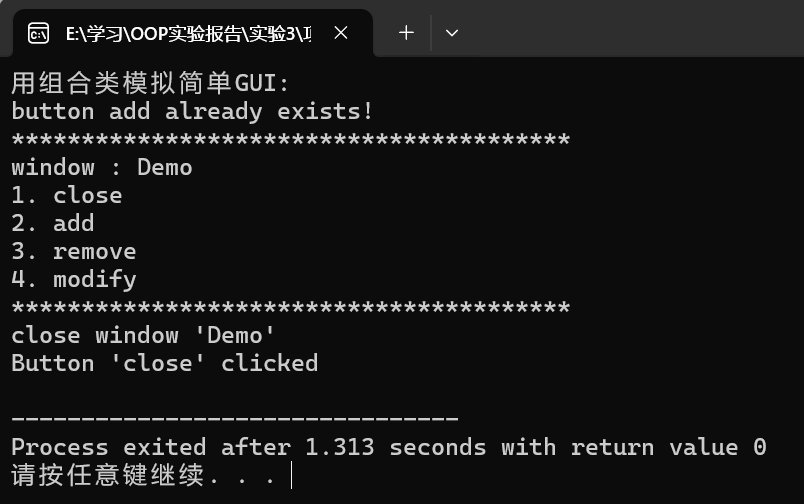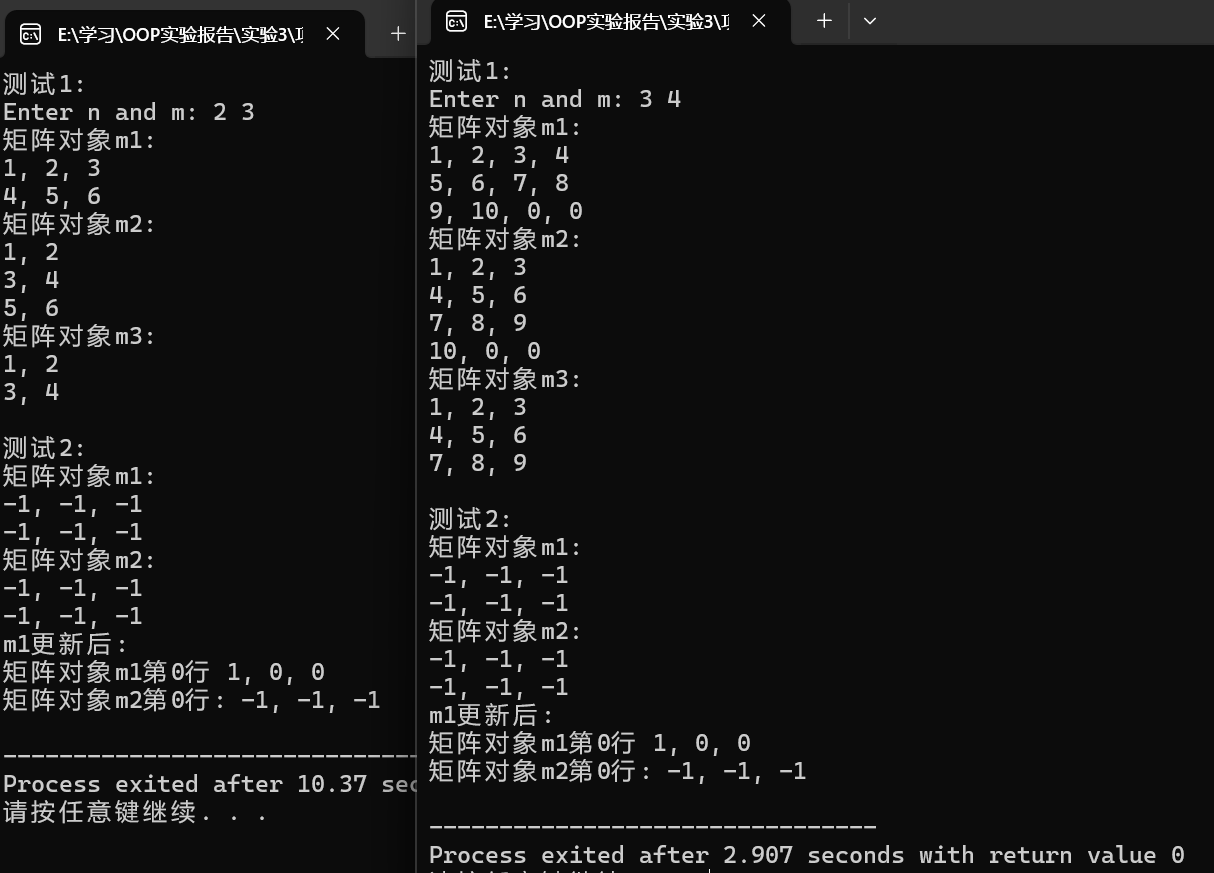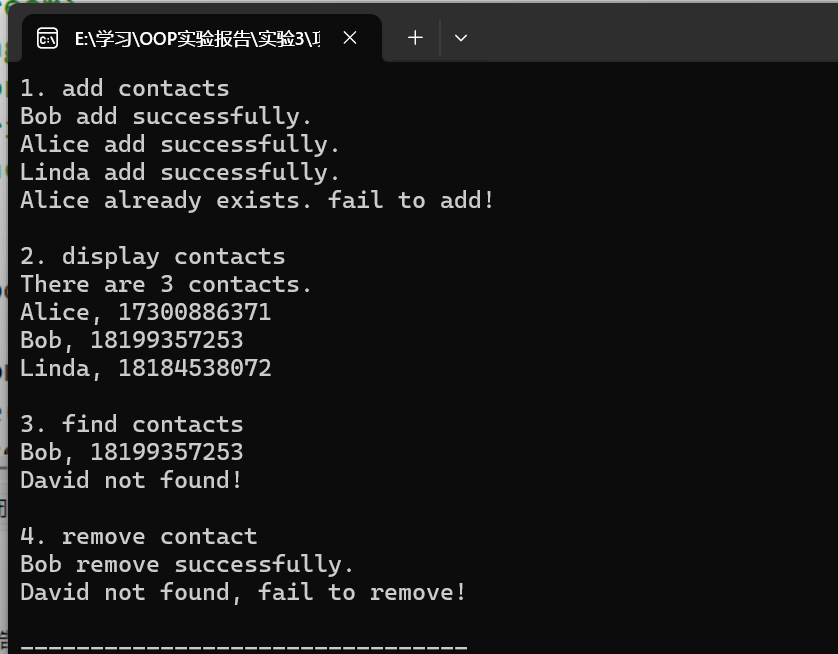实验3类和对象
实验任务1
源代码如下:
#pragma once #include <iostream> #include <string> class Button { public: Button(const std::string &label_); const std::string& get_label() const; void click(); private: std::string label; }; Button::Button(const std::string &label_): label{label_} { } inline const std::string& Button::get_label() const { return label; } inline void Button::click() { std::cout << "Button '" << label << "' clicked\n"; }
#pragma once #include <iostream> #include <vector> #include <algorithm> #include "button.hpp" // 窗口类 class Window{ public: Window(const std::string &title_); void display() const; void close(); void add_button(const std::string &label); void click_button(const std::string &label); private: bool has_button(const std::string &label) const; private: std::string title; std::vector<Button> buttons; }; Window::Window(const std::string &title_): title{title_} { buttons.push_back(Button("close")); } inline void Window::display() const { std::string s(40, '*'); std::cout << s << std::endl; std::cout << "window : " << title << std::endl; int cnt = 0; for(const auto &button: buttons) std::cout << ++cnt << ". " << button.get_label() << std::endl; std::cout << s << std::endl; } inline void Window::close() { std::cout << "close window '" << title << "'" << std::endl; click_button("close"); } inline bool Window::has_button(const std::string &label) const { for(const auto &button: buttons) if(button.get_label() == label) return true; return false; } inline void Window::add_button(const std::string &label) { if(has_button(label)) std::cout << "button " << label << " already exists!\n"; else buttons.push_back(Button(label)); } inline void Window::click_button(const std::string &label) { for(auto &button:buttons) if(button.get_label() == label) { button.click(); return; } std::cout << "no button: " << label << std::endl; }
#include "window.hpp" #include <iostream> void test(){ Window w("Demo"); w.add_button("add"); w.add_button("remove"); w.add_button("modify"); w.add_button("add"); w.display(); w.close(); } int main() { std::cout << "用组合类模拟简单GUI:\n"; test(); }
运行结果截图如下

问题一:是组合关系。Window里包含多个Button,Button随着Window的创建而创建,销毁而销毁。
问题二:
(1)优点:便于测试和调试,外部代码可以查询按钮是否存在。
缺点:破坏封装性,暴露内部代码细节;
外部代码可能通过此接口过add_button的检查逻辑来调用。
(2)可以通过两者不同的特点判断。
public:用户需要使用的功能;不改变对象的操作等。
private:仅作内部调用的辅助函数;设计改变对象状态的操作;涉及实现细节,用户不应关心的功能等。
问题三:接口1不拷贝直接返回引用;而接口2会先拷贝。接口1只读取故引用更快;接口2先拷贝则可以避免对原对象造成影响。
问题四:正常运行。和push不同,emplace直接在容器内构造对象,避免了不必要的拷贝。
实验任务2
源代码如下
#include <iostream> #include <vector> void test1(); void test2(); void output1(const std::vector<int> &v); void output2(const std::vector<int> &v); void output3(const std::vector<std::vector<int>>& v); int main() { std::cout << "深复制验证1: 标准库vector<int>\n"; test1(); std::cout << "\n深复制验证2: 标准库vector<int>嵌套使用\n"; test2(); } void test1() { std::vector<int> v1(5, 42); const std::vector<int> v2(v1); std::cout << "**********拷贝构造后**********\n"; std::cout << "v1: "; output1(v1); std::cout << "v2: "; output1(v2); v1.at(0) = -1; std::cout << "**********修改v1[0]后**********\n"; std::cout << "v1: "; output1(v1); std::cout << "v2: "; output1(v2); } void test2() { std::vector<std::vector<int>> v1{{1, 2, 3}, {4, 5, 6, 7}}; const std::vector<std::vector<int>> v2(v1); std::cout << "**********拷贝构造后**********\n"; std::cout << "v1: "; output3(v1); std::cout << "v2: "; output3(v2); v1.at(0).push_back(-1); std::cout << "**********修改v1[0]后**********\n"; std::cout << "v1: \n"; output3(v1); std::cout << "v2: \n"; output3(v2); } // 使用xx.at()+循环输出vector<int>数据项 void output1(const std::vector<int> &v) { if(v.size() == 0) { std::cout << '\n'; return; } std::cout << v.at(0); for(auto i = 1; i < v.size(); ++i) std::cout << ", " << v.at(i); std::cout << '\n'; } // 使用迭代器+循环输出vector<int>数据项 void output2(const std::vector<int> &v) { if(v.size() == 0) { std::cout << '\n'; return; } auto it = v.begin(); std::cout << *it; for(it = v.begin()+1; it != v.end(); ++it) std::cout << ", " << *it; std::cout << '\n'; } // 使用auto for分行输出vector<vector<int>>数据项 void output3(const std::vector<std::vector<int>>& v) { if(v.size() == 0) { std::cout << '\n'; return; } for(auto &i: v) output2(i); }
运行结果截图如下
 问题1:第一行是带参数创建v1,里面有5个数字,都是42;第二行用v1复制一份创建v2,也含5个42。
问题1:第一行是带参数创建v1,里面有5个数字,都是42;第二行用v1复制一份创建v2,也含5个42。
问题2: 2;2;3
问题3:效果一样,都能把第一个数改成-1
查阅后可知区别: at更安全,如果位置错了会提醒你;[]不检查,错了可能崩溃
问题4:(1) 能输出-1。因为r和v1[0]是同一个东西,v1[0]加了-1,r自然能看到
(2) 优势在于不复制,省内存;限制在于不能通过r修改数据
问题5(1) 深复制,修改v1时v2不变,说明它们彼此独立。
(2) 必须提供const版本。vector:at()返回的是int(可修改);const vector:at()返回的是const int(只读)。
实验任务3
源代码如下
#pragma once #include <iostream> // 动态int数组对象类 class vectorInt{ public: vectorInt(); vectorInt(int n_); vectorInt(int n_, int value); vectorInt(const vectorInt &vi); ~vectorInt(); int size() const; int& at(int index); const int& at(int index) const; vectorInt& assign(const vectorInt &vi); int* begin(); int* end(); const int* begin() const; const int* end() const; private: int n; // 当前数据项个数 int *ptr; // 数据区 }; vectorInt::vectorInt():n{0}, ptr{nullptr} { } vectorInt::vectorInt(int n_): n{n_}, ptr{new int[n]} { } vectorInt::vectorInt(int n_, int value): n{n_}, ptr{new int[n_]} { for(auto i = 0; i < n; ++i) ptr[i] = value; } vectorInt::vectorInt(const vectorInt &vi): n{vi.n}, ptr{new int[n]} { for(auto i = 0; i < n; ++i) ptr[i] = vi.ptr[i]; } vectorInt::~vectorInt() { delete [] ptr; } int vectorInt::size() const { return n; } const int& vectorInt::at(int index) const { if(index < 0 || index >= n) { std::cerr << "IndexError: index out of range\n"; std::exit(1); } return ptr[index]; } int& vectorInt::at(int index) { if(index < 0 || index >= n) { std::cerr << "IndexError: index out of range\n"; std::exit(1); } return ptr[index]; } vectorInt& vectorInt::assign(const vectorInt &vi) { if(this == &vi) return *this; int *ptr_tmp; ptr_tmp = new int[vi.n]; for(int i = 0; i < vi.n; ++i) ptr_tmp[i] = vi.ptr[i]; delete[] ptr; n = vi.n; ptr = ptr_tmp; return *this; } int* vectorInt::begin() { return ptr; } int* vectorInt::end() { return ptr+n; } const int* vectorInt::begin() const { return ptr; } const int* vectorInt::end() const { return ptr+n; }
#include "vectorInt.hpp" #include <iostream> void test1(); void test2(); void output1(const vectorInt &vi); void output2(const vectorInt &vi); int main() { std::cout << "测试1: \n"; test1(); std::cout << "\n测试2: \n"; test2(); } void test1() { int n; std::cout << "Enter n: "; std::cin >> n; vectorInt x1(n); for(auto i = 0; i < n; ++i) x1.at(i) = (i+1)*10; std::cout << "x1: "; output1(x1); vectorInt x2(n, 42); vectorInt x3(x2); x2.at(0) = -1; std::cout << "x2: "; output1(x2); std::cout << "x3: "; output1(x3); } void test2() { const vectorInt x(5, 42); vectorInt y; y.assign(x); std::cout << "x: "; output2(x); std::cout << "y: "; output2(y); } // 使用xx.at()+循环输出vectorInt对象数据项 void output1(const vectorInt &vi) { if(vi.size() == 0) { std::cout << '\n'; return; } std::cout << vi.at(0); for(auto i = 1; i < vi.size(); ++i) std::cout << ", " << vi.at(i); std::cout << '\n'; } // 使用迭代器+循环输出vectorInt对象数据项 void output2(const vectorInt &vi) { if(vi.size() == 0) { std::cout << '\n'; return; } auto it = vi.begin(); std::cout << *it; for(it = vi.begin()+1; it != vi.end(); ++it) std::cout << ", " << *it; std::cout << '\n'; }
运行结果截图如下

问题1:安全隐患:自赋值问题(若自己赋值给自己会崩溃,即先删内存,再复制自己);
如果new中内存分配失败,对象状态会错乱。
问题2:at()函数的重载实现
(1) static_cast<const vectorInt*>(this)的作用:
转换前:vectorInt*(普通指针)
转换后:const vectorInt*(常量指针)
目的:为了能调用const版本的at()函数
(2) const_cast<int&>的作用:
转换前:const int&(常量引用)
转换后:int&(普通引用)
目的:把const版本的返回值转成非const的,让外部可以修改
问题三:重载版本选择:
auto it1 = v1.begin(); 调用非const版本,返回 int*
auto it2 = v2.begin(); 调用const版本,返回 const int*
使用场景:
非const版本:需要修改数据时使用
const版本:只读访问时使用,保证数据安全
问题4:可以。对应功能如下:从ptr位置开始,填充n个value值;从v1.ptr复制v1.n个元素到pt;从v1.ptr复制v1.n个元素到ptr_tmp。
实验任务4
源代码如下
#pragma once #include <iostream> #include <algorithm> #include <cstdlib> // 类Matrix声明 class Matrix { public: Matrix(int rows_, int cols_, double value = 0); // 构造rows_*cols_矩阵对象, 初值value Matrix(int rows_, double value = 0); // 构造rows_*rows_方阵对象, 初值value Matrix(const Matrix &x); // 深复制 ~Matrix(); void set(const double *pvalue, int size); // 按行复制pvalue指向的数据,要求size=rows*cols,否则报错退出 void clear(); // 矩阵对象数据项置0 const double& at(int i, int j) const; // 返回矩阵对象索引(i,j)对应的数据项const引用(越界则报错后退出) double& at(int i, int j); // 返回矩阵对象索引(i,j)对应的数据项引用(越界则报错后退出) int rows() const; // 返回矩阵对象行数 int cols() const; // 返回矩阵对象列数 void print() const; // 按行打印数据 private: int n_rows; // 矩阵对象内元素行数 int n_cols; // 矩阵对象内元素列数 double *ptr; // 数据区 };
#include <iostream> #include <cstdlib> #include "matrix.hpp" void test1(); void test2(); void output(const Matrix &m, int row_index); int main() { std::cout << "测试1: \n"; test1(); std::cout << "\n测试2: \n"; test2(); } void test1() { double x[1000] = {1, 2, 3, 4, 5, 6, 7, 8, 9, 10}; int n, m; std::cout << "Enter n and m: "; std::cin >> n >> m; Matrix m1(n, m); // 创建矩阵对象m1, 大小n×m m1.set(x, n*m); // 用一维数组x的值按行为矩阵m1赋值 Matrix m2(m, n); // 创建矩阵对象m2, 大小m×n m2.set(x, m*n); // 用一维数组x的值按行为矩阵m1赋值 Matrix m3(n); // 创建一个n×n方阵对象 m3.set(x, n*n); // 用一维数组x的值按行为矩阵m3赋值 std::cout << "矩阵对象m1: \n"; m1.print(); std::cout << "矩阵对象m2: \n"; m2.print(); std::cout << "矩阵对象m3: \n"; m3.print(); } void test2() { Matrix m1(2, 3, -1); const Matrix m2(m1); std::cout << "矩阵对象m1: \n"; m1.print(); std::cout << "矩阵对象m2: \n"; m2.print(); m1.clear(); m1.at(0, 0) = 1; std::cout << "m1更新后: \n"; std::cout << "矩阵对象m1第0行 "; output(m1, 0); std::cout << "矩阵对象m2第0行: "; output(m2, 0); } // 输出矩阵对象row_index行所有元素 void output(const Matrix &m, int row_index) { if(row_index < 0 || row_index >= m.rows()) { std::cerr << "IndexError: row index out of range\n"; exit(1); } std::cout << m.at(row_index, 0); for(int j = 1; j < m.cols(); ++j) std::cout << ", " << m.at(row_index, j); std::cout << '\n'; }
#include "matrix.hpp" #include <cstdlib> #include <cstring> #include <algorithm> Matrix::Matrix(int rows_, int cols_, double value) : n_rows(rows_), n_cols(cols_), ptr(new double[rows_ * cols_]) { if (rows_ <= 0 || cols_ <= 0) std::exit(1); std::fill(ptr, ptr + n_rows * n_cols, value); } Matrix::Matrix(int rows_, double value) : Matrix(rows_, rows_, value) {} Matrix::Matrix(const Matrix &x) : n_rows(x.n_rows), n_cols(x.n_cols), ptr(new double[n_rows * n_cols]) { std::memcpy(ptr, x.ptr, n_rows * n_cols * sizeof(double)); } Matrix::~Matrix() { delete[] ptr; } void Matrix::set(const double *pvalue, int size) { if (size != n_rows * n_cols) std::exit(1); std::memcpy(ptr, pvalue, size * sizeof(double)); } void Matrix::clear() { std::fill(ptr, ptr + n_rows * n_cols, 0.0); } const double& Matrix::at(int i, int j) const { if (i < 0 || i >= n_rows || j < 0 || j >= n_cols) std::exit(1); return ptr[i * n_cols + j]; } double& Matrix::at(int i, int j) { return const_cast<double&>(static_cast<const Matrix&>(*this).at(i, j)); } int Matrix::rows() const { return n_rows; } int Matrix::cols() const { return n_cols; } void Matrix::print() const { for (int i = 0; i < n_rows; ++i) { std::cout << at(i, 0); for (int j = 1; j < n_cols; ++j) { std::cout << ", " << at(i, j); } std::cout << '\n'; } }
运行结果截图如下

实验任务5
源代码如下
#pragma once #include <iostream> #include <string> // 联系人类 class Contact { public: Contact(const std::string &name_, const std::string &phone_); const std::string &get_name() const; const std::string &get_phone() const; void display() const; private: std::string name; // 必填项 std::string phone; // 必填项 }; Contact::Contact(const std::string &name_, const std::string &phone_):name{name_}, phone{phone_} { } const std::string& Contact::get_name() const { return name; } const std::string& Contact::get_phone() const { return phone; } void Contact::display() const { std::cout << name << ", " << phone; }
# pragma once #include <iostream> #include <string> #include <vector> #include <algorithm> #include "contact.hpp" // 通讯录类 class ContactBook { public: void add(const std::string &name, const std::string &phone); // 添加联系人 void remove(const std::string &name); // 移除联系人 void find(const std::string &name) const; // 查找联系人 void display() const; // 显示所有联系人 size_t size() const; private: int index(const std::string &name) const; // 返回联系人在contacts内索引,如不存在,返回-1 void sort(); // 按姓名字典序升序排序通讯录 private: std::vector<Contact> contacts; }; void ContactBook::add(const std::string &name, const std::string &phone) { if(index(name) == -1) { contacts.push_back(Contact(name, phone)); std::cout << name << " add successfully.\n"; sort(); return; } std::cout << name << " already exists. fail to add!\n"; } void ContactBook::remove(const std::string &name) { int i = index(name); if(i == -1) { std::cout << name << " not found, fail to remove!\n"; return; } contacts.erase(contacts.begin()+i); std::cout << name << " remove successfully.\n"; } void ContactBook::find(const std::string &name) const { int i = index(name); if(i == -1) { std::cout << name << " not found!\n"; return; } contacts[i].display(); std::cout << '\n'; } void ContactBook::display() const { for(auto &c: contacts) { c.display(); std::cout << '\n'; } } size_t ContactBook::size() const { return contacts.size(); } // 待补足1:int index(const std::string &name) const;实现 // 返回联系人在contacts内索引; 如不存在,返回-1 int ContactBook::index(const std::string &name) const { for (size_t i = 0; i < contacts.size(); ++i) { if (contacts[i].get_name() == name) { return static_cast<int>(i); } } return -1; } // 待补足2:void ContactBook::sort();实现 // 按姓名字典序升序排序通讯录 void ContactBook::sort() { std::sort(contacts.begin(), contacts.end(), [](const Contact& a, const Contact& b) { return a.get_name() < b.get_name(); }); }
#include "contactBook.hpp" void test() { ContactBook contactbook; std::cout << "1. add contacts\n"; contactbook.add("Bob", "18199357253"); contactbook.add("Alice", "17300886371"); contactbook.add("Linda", "18184538072"); contactbook.add("Alice", "17300886371"); std::cout << "\n2. display contacts\n"; std::cout << "There are " << contactbook.size() << " contacts.\n"; contactbook.display(); std::cout << "\n3. find contacts\n"; contactbook.find("Bob"); contactbook.find("David"); std::cout << "\n4. remove contact\n"; contactbook.remove("Bob"); contactbook.remove("David"); } int main() { test(); }
运行结果截图如下

总结
这次做的比较仓促,等之后再做一下实验的延申和思考。主要的收获再一次加深了对public和private的划分方法,区分清楚类之间的关系例如组合、依赖等等的模式和功能以及应当注意的条件和限制;另外尤其加深了对const的理解还有一些vector的使用。





 浙公网安备 33010602011771号
浙公网安备 33010602011771号